Independent Traditions:
A Parisian Bookseller's Chronicle
One manuscript of the Grandes Chroniques (B.N. fr. 10132), probably finished in the 1320s and continued again in the mid-fourteenth century, illustrates the extent to which available models affected the form of cycles. This book was commissioned from Thomas of Maubeuge, a noted Parisian libraire , by Pierre Honnorez of Neufchâtel in Normandy.[22] Apparently Thomas based his manuscript on a copy of the Grandes Chroniques to 1223, which copies an exemplaire that seems to have circulated among Parisian booksellers until the early fifteenth century, and supplemented that text with Guillaume de Nangis's amplified chronicle for the lives of Louis VIII through Louis X.[23] To organize the text Thomas turned not to royal or courtly models of the Grandes Chroniques but to contemporary vernacular histories, specifically to the Abrégé de l'histoire de France by the Ménestrel of Alphonse of Poitiers, one of the texts whose prologue was adapted for the Grandes Chroniques .[24]
This copy of the Grandes Chroniques is the only one whose text follows the tripartite division outlined in the section of the prologue taken from the Ménestrel's chronicle and used to structure manuscripts of that text. Thomas of Maubeuge did as the derivative section of the Grandes Chroniques 's prologue mandates: he divided the history into three principal books that deal with the "generations" of Meroveus, Pepin, and Hugh Capet. To clarify the organization of the text further, Thomas provided a genealogically structured table of contents in the first gathering, which was added after the manuscript was completed through the life of Louis X. Besides listing certain important passages and noting the folios on which they appear, the chapter list explains how to use the text when it is divided into three: "And to know how to find the generation by the number, you will find in the first generation on each page the number .i., in the second .ii., and in the third .iii. And thus you will find the things which are there."[25] Within each of the subdivisions of the text proper the pagination begins anew.
The earliest manuscripts of the Abrégé de l'histoire de France , dating from the thirteenth century, append genealogical trees that function like Thomas's genealogically ordered chapter list.[26] These diagrams distinguish the Merovingians, Carolingians, and Capetians from one another so clearly that few other illustrations are needed.[27] As a result, the Abrégé provided few pictorial models for Thomas. The textual relationship between these books therefore makes the independence of Thomas's illustrations even more noteworthy. Indeed, they differ distinctly from the few illustrated manuscripts of the Abrégé and from the copies of the Grandes Chroniques produced under courtly or Dionysian patronage. In selecting his pictures, Thomas seems to have forged an independent cycle—one that may provide insights into nonroyal uses of history in the early fourteenth century.
Directions to the rubricator and illuminator preserved in B.N. fr. 10132[28] suggest that the genesis of this pictorial cycle was similar to that described for contemporary romances. In romances verbal guides written as directions to the illuminator often indicated the subjects for illuminations and explanatory captions in the form of rubrics often summarized the chapters and explained their miniatures.[29]
In B.N. fr. 10132 this practice was limited to material derived from the first of the two textual models used for the portion of this Grandes Chroniques finished in the 1320s.[30] Apparently Thomas used a fully rubricated copy of Guillaume de Nangis's amplified chronicle for the second portion of the manuscript describing events from 1223 to 1316, because that part has rubrics for every chapter and contains no marginal guides to the illuminator or rubricator. In contrast the Grandes Chroniques to 1223 that Thomas used as a source for the first portion of the book seems not to have been fully rubricated. Because original rubrics and notes to the illuminator survive in that part of the manuscript, the creative process involved in emphasizing selected texts and images is most evident there.
With the exception of the fourth book of the lives of the Merovingians, which has rubrics for each chapter, rubrication is scattered in the portion of Thomas's text based on the Grandes Chroniques . Not all illustrated chapters have rubrics, and not all rubricated chapters have illustrations. Nonetheless, selected cases in which a rare combination of directions to the illuminator and rubricator survives demonstrate how the libraire constructed the pictorial cycle.[31]
These marginal directions were first published by Berger and Durrieu, who described the positions of the notes to the rubricator in the lower or side margins and the notes to the illuminator in the lower margins.[32] They suggested that the notes were written by two separate hands: the first, the scribe of the text and rubric, wrote notes for the rubricator, and the second wrote notes for the illuminator in a more cursive hand. Berger and Durrieu concluded that Thomas of Maubeuge's Grandes Chroniques was created through the successive intervention of three people: the copyist, who was also the rubricator; the director of the illumination; and the illuminator.
Gilbert Ouy's suggestion that the two sets of directions were written by the same hand employing different styles of script presents a different vision of the creation of the book in which at any given time one person was responsible for copying the text, writing the notes dictating the content of rubrics and subjects for illumination, and rubricating the manuscript.[33] Certain inaccuracies in the pictorial cycle support his observation. For example, on folio 256 (Figs. 22 and 23) the directions to the illuminator follow the notes to the rubricator in the lower margin. First is the note for the rubric that celebrates King Robert's descent from Hugh Capet and his scholarly bent, and second is the note for the illumination that describes how, with plenty of soldiers, he besieges a city.[34] It seems likely that someone wrote the note to the illuminator after completing the note to the rubricator; for that person the "he" of the illuminator's note was clearly King Robert, who had just been mentioned by name in the rubricator's note. Robert's identity was not so clear to the artist, who apparently read only the notes written in the script used for directions about pictorial content. He painted a generic scene of knights approaching a castle, rather than a king leading a siege.[35] When directions to the rubricator and the illuminator were not juxtaposed on the same folio, the scribe knew that the artist would not have seen the note to the rubricator and was careful to specify in the direction to the artist the presence of "the king" or "the emperor." The artists followed these directions, thereby producing more accurate representations of the events described in the chapter than those produced on folios where directions to the illuminator immediately
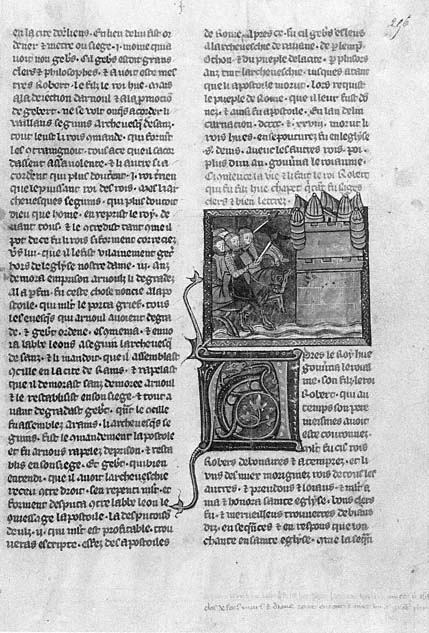
Figure 22
Knights approach a castle. Grandes Chroniques de France . Bibliothèque
Nationale, Ms. fr. 10132, fol. 256. Photograph: Bibliothèque Nationale, Paris.
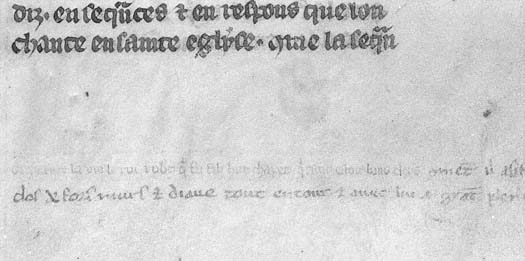
Figure 23
Notes to the illuminator and rubricator. Grandes Chroniques de France . Bibliothèque Nationale,
Ms. fr. 10132, fol. 256. Photograph: Bibliothèque Nationale, Paris.
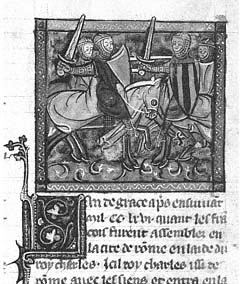
Figure 24
Battle of Charles of Anjou and Manfred.
Grandes Chroniques de France .
Bibliothèque Nationale, Ms. fr. 10132, fol.
371v.
Photograph: Bibliothèque Nationale, Paris.
followed directions to the rubricator. This occurs whether the directions to the rubricator and illuminator are on facing pages (fols. 219v–20 and 240v–41) or on the recto and verso of one folio (fols. 252–52v and 255–55v).
Most miniatures in Thomas's manuscript are essentially schematic compositions. The treatment of pictures showing battles exemplifies the way in which the artist who followed the marginal notes tailored these stock scenes to fit various situations. The battle of Manfred and Charles of Anjou (Fig. 24) represents the basic composition—a confrontation between a king and a knight on ground defined by hillocks made of black and white swirls. Artists could add details to this basic image. Extra knights and portions of dismembered bodies appear in the battle of Charles of Anjou against Conradin and Henry of Spain (Fig. 25); in a miniature painted by this artist in a later copy of the Grandes Chroniques (Castres, B.M.) trees fill in the representation of a preliminary skirmish before the battle of Bouvines (Fig. 26), and a complement of knights aid Philip Augustus in that battle (Fig. 27). Although none of the instructions for these specific pictures survive, it is quite likely that the directions given the artist for each of these miniatures specified the representation of a battle and that he adapted a stock scene to fill the need.[36]
The relation between the content of the illuminations and the rubrics that act as explanatory captions is revealing as well. When directions to the illuminator are present, pictures never depend exclusively on the rubric; in fact, in 17 of the 19 cases where directions to the illuminator survive, the rubric is very
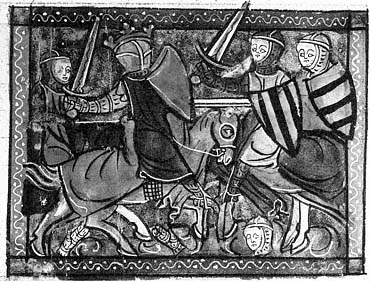
Figure 25
Battle of Charles of Anjou against Conradin and Henry of Spain.
Grandes Chroniques de France . Bibliothèque Nationale, Ms. fr.
10132, fol. 372. Photograph: Bibliothèque Nationale, Paris.
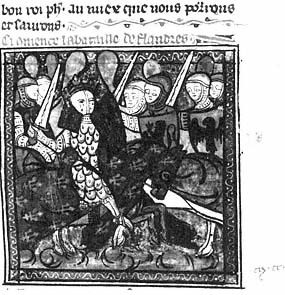
Figure 26
Battle of Bouvines. Grandes Chroniques de France .
Castres, Bibliothèque Municipale, fol. 282v.
Photograph: Bibliothèque Municipale, Castres.
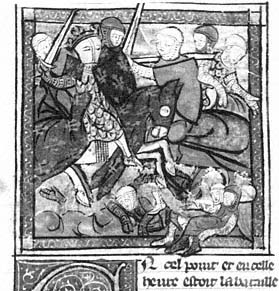
Figure 27
Capture of Ferrand. Grandes Chroniques de
France . Castres, Bibliothèque Municipale, fol. 285.
Photograph: Bibliothèque Municipale, Castres.
simple, introducing a book dedicated to the life of a king.[37] In the two cases where the rubrics are more elaborate, the pictures still follow the directions to the illuminator. However, when directions to the illuminator are absent, pictures often illustrate more elaborate rubrics that function as captions. The most obvious examples of this occur in a sequence of four rubrics in Books I–III, which provide such detailed descriptions that they could function as directions to the illuminator, although only three are illustrated in B.N. fr. 10132. These captions differ from those given in the chapter list and in such earlier copies of the chronicle as Ste.-Gen. 782. They seem to have been part of a text that circulated among Parisian libraires , because they resurfaced in a number of late fourteenth- and early fifteenth-century manuscripts of the Grandes Chroniques .[38]
Although most images in this Grandes Chroniques are composites assembled by the artist from stock compositions to illustrate written directions for "a battle," the cycle itself was carefully constructed. Indeed, the structure of this cycle of illustration differs distinctly from those that I have termed "royal" or "genealogical." The first two pictures in particular reinforce the preoccupation with dynasties exhibited in the tripartite division of text in this Grandes Chroniques . The first miniature depicts the destruction of and flight from Troy (Fig. 28). Its placement at the beginning of the prologue is rare, because the Trojan story forms part of the first chapter of Book I. A unique image derived from the iconography of the tree of Jesse (Fig. 29) displaced the Trojan image as an illustration for the first book of the chronicle. It shows a recumbent king from whom grows a tree bearing fruits that are crowned and uncrowned male heads.
The rubrics for these two pictures establish a relationship between them. A rubric under the illustration of the destruction of Troy is better suited to explain the tree: "Here begins a genealogy of the dukes who reigned before there was any king in France, and then, of the kings who reigned after them."[39] The image of the tree of descent shows the uncrowned heads (dukes) and crowned heads (kings) forming part of the same tree. Its rubric alludes to the destruction: "Here begins a genealogy of the kings of France and how they descended first from those who fled Troy."[40] The displacement of the Trojan scene to include the tree of descent at the beginning of Book I emphasizes the importance to this book of the length of the French line. This unique combination of text and image reflects the special concern with genealogy and succession outlined in the prologue of the Grandes Chroniques , a preoccupation reinforced by the introductory materials (fols. 1–6v) added to this manuscript to clarify its division into three parts.
The treatment of the reditus provides one of the most telling examples of how the perspective of Thomas of Maubeuge and Pierre of Neufchâtel, his patron, on the reading and picturing of history differed from that represented in the first version of the Grandes Chroniques .[41] In Philip III's Grandes Chroniques the reditus provides the underlying structural principle for the whole cycle. Pictures of Charlemagne and of Philip Augustus are of large scale, and textual references connect the two in a complex interrelationship. The expression of the reditus and the implications for French legitimacy of the return of government to descendants of Charlemagne were important to both the abbey of Saint-Denis and to Philip III.
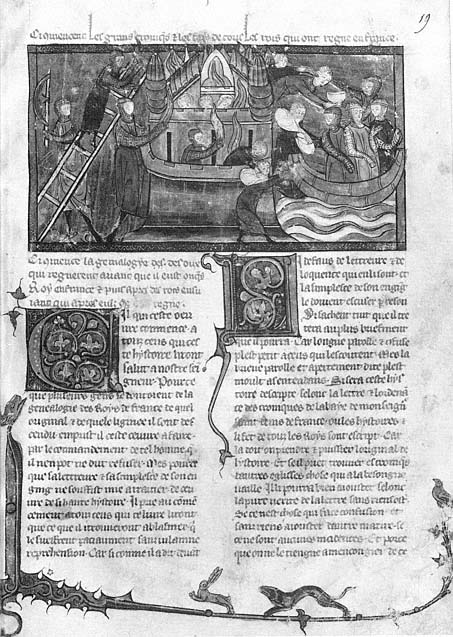
Figure 28
Destruction of Troy. Grandes Chroniques de France . Bibliothèque Nationale, Ms. fr.
10132, fol. 19. Photograph: Bibliothèque Nationale, Paris.
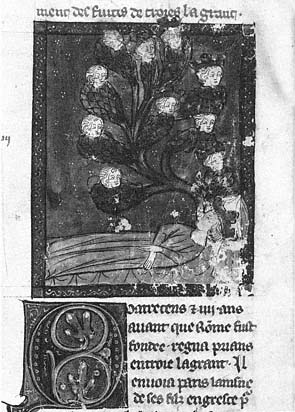
Figure 29
Tree of descent. Grandes Chroniques de France .
Bibliothèque Nationale, Ms. fr. 10132, fol. 20v.
Photograph: Bibliothèque Nationale, Paris.
The reditus is not an important concept in the Grandes Chroniques directed by Thomas of Maubeuge. In this manuscript the life of Hugh Capet, in which the reditus is first mentioned, is illustrated by a rare scene of the marriage of Philip Augustus and Elizabeth of Hainaut (Fig. 30), the deed by which the reditus was accomplished. Because this image is unusual, a reader might interpret it as a deliberate visualization of a political prophecy. Nothing could be further from the truth. Indeed, this seemingly innovative picture was the easiest way to illustrate the text that follows it. As the first event described in the chapter to lend itself to visual formulation, the marriage of Philip and Elizabeth found its way into the list of directions to the illuminator, where it is described, "How the king marries a woman and several knights and many clergy are there."[42]
The text and image for the life of Louis VIII in the manuscript commissioned from Thomas of Maubeuge support this interpretation of the reditus miniature. The official life of Louis VIII preserved in contemporary manuscripts of the
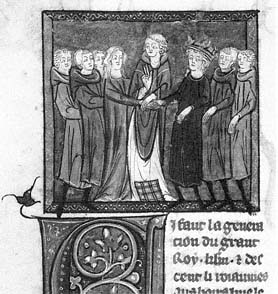
Figure 30
Marriage of Philip Augustus and Elizabeth of
Hainaut. Grandes Chroniques de France .
Bibliothèque Nationale, Ms. fr. 10132, fol. 255v.
Photograph: Bibliothèque Nationale, Paris.
Grandes Chroniques includes an extended celebration of the reditus .[43] The continuation employed by Thomas of Maubeuge in this Grandes Chroniques plays down the prophecy, and the illustration of the chapter ignores it, representing Louis VIII receiving a messenger.[44]
A consideration of pictures that depart from the traditional layout followed in this manuscript (in which a miniature begins each book of the chronicle) makes clear what themes attracted either Thomas of Maubeuge or Pierre of Neufchâtel. Nine pictures subdivide books in this copy of the Grandes Chroniques .[45] These reveal interest in such heroes of French history as Clovis, Dagobert, and Pepin and demonstrate a desire to document Charlemagne's acquisition of relics that, at the time of this manuscript's execution, were thought to be kept at Saint-Denis.
In summary, what is most important about Pierre of Neufchâtel's Grandes Chroniques is the insight it provides into popular cycles of the chronicle. Both the pictorial cycle and the textual organization of this manuscript are very different from contemporary Dionysian, royal, and courtly programs. Thomas of Maubeuge was the only editor to be faithful to the division of the texts outlined in the prologue of the Grandes Chroniques and to attempt in the first few illustrations of the program to reinforce the prologue's dynastic message. Both the organization of the text and the paired introductory miniatures in this copy of the chronicle concentrate on the succession of the three races of French kings. Although the
rest of the cycle is less innovative, it is nonetheless an important source for examining aspects of the history that interested the broader audience who bought manuscripts from libraires . This chronicle manifests less concern with questions of dynastic succession than preoccupation with traditional French heroes. Unlike many royal and courtly manuscripts of the Grandes Chroniques , which were tied closely to royal self-perception and to the changing political situation in France, such apolitical manuscripts as that commissioned from Thomas of Maubeuge retained their popularity through the reigns of the early Valois.[46]